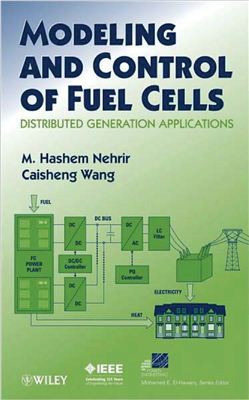Wiley-IEEE Press, 2009. 315 p. ISBN:0470233281.
Fuel cells (FCs) have caught intensive attention in the last decade. Following their successful development for the manned space program by the U.S. National Aeronautical and Space Administration (NASA) in the 1960s, significant advances have been achieved in the fuel cell technology and the applications of different types of fuel cells.
Environmental conces and world-wide social and political pressure to reduce carbon dioxide emission, and the desire to seek higher energy conversion efficiencies in electrical power generation, have been the main drivers for fuel cell technological advances and their applications, including distributed power generation and fuel cell vehicle applications. Electrical power producers are seeking ways to gain competitive position in the deregulated power market by contributing to reduced environmental emissions. In addition, as a part of the requirement to pursue technologies to reduce carbon emissions, the automobile industry has started FC vehicle
development with the ultimate goal of reaching zero-emission car.
The book begins with a fascinating introduction to the subject, including a brief history of the U.S. electric utility formation and restructuring. Next, it provides coverage of power deregulation and distributed generation (DG), DG types, fuel cell DGs, and the hydrogen economy. Building on that foundation, it covers:
* Principle operations of fuel cells
* Dynamic modeling and simulation of PEM and solid-oxide fuel cells
* Principle operations and modeling of electrolyzers
* Power electronic interfacing circuits for fuel cell applications
* Control of grid-connected and stand-alone fuel cell power generation systems
* Hybrid fuel cell–based energy system case studies
* Present challenges and the future of fuel cells
MATLAB/SIMULINK-based models and their applications are available via a companion Web site. Modeling and Control of Fuel Cells is an excellent reference book for students and professionals in electrical, chemical, and mechanical engineering and scientists working in the FC area.
Fuel cells (FCs) have caught intensive attention in the last decade. Following their successful development for the manned space program by the U.S. National Aeronautical and Space Administration (NASA) in the 1960s, significant advances have been achieved in the fuel cell technology and the applications of different types of fuel cells.
Environmental conces and world-wide social and political pressure to reduce carbon dioxide emission, and the desire to seek higher energy conversion efficiencies in electrical power generation, have been the main drivers for fuel cell technological advances and their applications, including distributed power generation and fuel cell vehicle applications. Electrical power producers are seeking ways to gain competitive position in the deregulated power market by contributing to reduced environmental emissions. In addition, as a part of the requirement to pursue technologies to reduce carbon emissions, the automobile industry has started FC vehicle
development with the ultimate goal of reaching zero-emission car.
The book begins with a fascinating introduction to the subject, including a brief history of the U.S. electric utility formation and restructuring. Next, it provides coverage of power deregulation and distributed generation (DG), DG types, fuel cell DGs, and the hydrogen economy. Building on that foundation, it covers:
* Principle operations of fuel cells
* Dynamic modeling and simulation of PEM and solid-oxide fuel cells
* Principle operations and modeling of electrolyzers
* Power electronic interfacing circuits for fuel cell applications
* Control of grid-connected and stand-alone fuel cell power generation systems
* Hybrid fuel cell–based energy system case studies
* Present challenges and the future of fuel cells
MATLAB/SIMULINK-based models and their applications are available via a companion Web site. Modeling and Control of Fuel Cells is an excellent reference book for students and professionals in electrical, chemical, and mechanical engineering and scientists working in the FC area.

